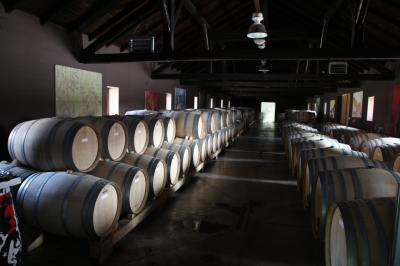Winemaking


The harvest at Midalidare is carried out solely by hand. Depending on weather conditions it starts around the second half of August with the grapes for the sparklings and ends at the beginning of November with the Cabernet Sauvignon and Malbec. Manually harvested grapes are carried out with 10-12 kg boxes in order to prevent berries from crushing or damaging. Having vineyards close to the wineries is huge advantage for Midalidare since the grapes are immediately sent to the coolers – the outermost vineyard is 4 kilometers away from the winemaking bases. After 24-hour cooling the grapes are carefully double sorted by hand. At first the whole clusters are sorted and after being destemmed, the second sorting of the grapes is carried out. Depending on the variety and winemaking technology the grapes could be pressed or not. And finally, the grapes are sent by gravity to wine tanks for fermentation.
Traditional Sparkling winemaking
Traditional method of sparkling winemaking consists of numerous strictly observed processes. Midalidare sparkling winemaking follows the principles and practices that were built hundreds of years ago. It starts with step-by-step fractioned whole-cluster pressing and separating the fractions. Clarification, decanting and primary fermentation at controlled temperature precede the ageing on the lees, blending and cold stabilization. Then, sterile filtration, adding yeasts and “liqueur de tirage” are the preparation for the fermentation in bottle. A few hours after the wine is bottled, stopped with a crown cap and stored in a wine cellar horizontally for a second fermentation. The second fermentation is carried out for about 40 days at controlled temperature. During the process the pressure inside the bottle increases from 0 to 7 bars. The following process is ageing on the lees at controlled low temperature, for 24 to 60 or more months. After ageing, the bottles undergo a process known as remuage (riddling). Тhe bottles are placed on special racks called pupitres, with the crown cap pointed down. Daily, several times a day, the bottles are given a turn with the angle gradually increased. For the process of degorgement the bottles are placed upside down and the bottle neck is freezed. The crown cap is then popped off which allows the frozen lees to shoot out of the pressurized bottle. The liquid level is complemented with “liqueur d'expedition” (dosage) and the wine is bottled and corked. At the end of his long winemaking process, Midalidare sparkling wines are aged for at least 3 months in bottle.
Vinification of white wines
Following the harvest and double sorting, the white grapes enter a pres. Depending on the variety and technology a cold soak could take place in order to allow aromas from the skin to penetrate the grape juice. The grapes are strained and delicately pressed into a stainless steel tank with a capacity of 500 to 5000 liters or oak barrel (for high level whites). Clarification for a few days preceded the yeasts introduction and 15-25 days fermentation at controlled temperature. The process is followed by cooling the wine and maturing on the lees (duration differs for different varieties and it comes to the judgment of Midalidare’s oenologists). Several times a week batonnage is carried out. Then follows filtration, clarification and bottling.
Vinification of rose wines
The harvest for rose wines at Midalidare is carried out earlier than the one of the same grape varieties for red wine. Thereby the varietal aromas and the acidity of the grapes are preserved. Vinification is carried out using the technology of white wine production. Harvested and selected red grapes are fed into the cold press to allow the aroma and color of the skin to penetrate the grape juice. Then, the grapes are strained and delicately pressed into a stainless-steel tank with a capacity of 500 to 5000 liters or oak barrel (for Rose de Mourvedre Single Barrel). Clarification for a few days preceded the yeasts introduction and about two weeks fermentation at controlled temperature. The process is followed by cooling the wine and sitting on the lees (from a week to a few months). Several times a week batonnage is carried out. Then follows filtration, clarification and bottling.
Vinification of red wines
The harvested black grapes enter stainless fermenters whose shape resemble an open wooden vat, specially designed by Midalidare. There, at controlled temperature, cold soak takes place for 10-20 days in order to obtain maximum coloring substance and fruity flavor from the skin. Gentle warming preceded the yeast's introduction and fermentation at controlled temperature. Depending on the variety and the oenologist’s decision a post maceration takes place for certain time. Then the wine is drained from the fermenters and is fed for ageing into new to second fill French oak barrels.
Oak fermentation
One-third of the fermentation capacity in both of Midalidare's wineries consists of oak barrels. For white wines oak fermentation, new barrels are always used, specially selected according to the variety and wine style. The high-level red wines ferment in French oak barrels with capacity of 400 liters, which provides an additional concentration of aroma, structure and ageing potential. Barrels at Midalidare are used up to second fill.
Ageing
Only 225-litres French oak barrels are used for aging at Midalidare. During the ageing the wines are regularly refilled and analyzed for the qualitative changes that may occur as a consequence of the contact with the wood. Different types of French oak from several regions of France are used, with varying degrees of toasting. Most of the premium wines ferment entirely into oak barrels. All of Midalidare's red wines are barrel aged. Oenologists determine when wine should be taken out of the barrels. Rough filtration and bottling follow. Wines are not processed (any further processing would affect the quality of the wine) so it is possible that natural sediment will form during the bottle aging - small "crystals" in white wines and coloring substance in the reds.
